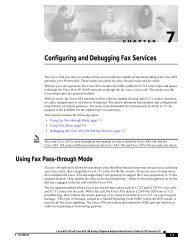Cisco ATA 186 and Cisco ATA 188 Analog Telephone Adaptor ...
Cisco ATA 186 and Cisco ATA 188 Analog Telephone Adaptor ...
Cisco ATA 186 and Cisco ATA 188 Analog Telephone Adaptor ...
You also want an ePaper? Increase the reach of your titles
YUMPU automatically turns print PDFs into web optimized ePapers that Google loves.
Configuring the <strong>Cisco</strong> <strong>ATA</strong> Using a TFTP Server<br />
Chapter 3<br />
Configuring the <strong>Cisco</strong> <strong>ATA</strong> for SIP<br />
Step 4<br />
Use the sip_example.txt file again, this time as a template for creating a text file of values that are<br />
specific to one <strong>Cisco</strong> <strong>ATA</strong>. For example, you might configure the following parameters:<br />
UserID:8530709<br />
GkorProxy:192.168.1.1<br />
Save this file of <strong>Cisco</strong> <strong>ATA</strong>-specific parameters as:<br />
ata.txt<br />
where macaddress is the non-dotted hexadecimal version of the MAC address of the <strong>Cisco</strong> <strong>ATA</strong> you are<br />
configuring. This non-dotted hexadecimal MAC address is labeled on the bottom of most <strong>Cisco</strong> <strong>ATA</strong>s<br />
next to the word “MAC.” The file name must be exactly 15 characters long. (However, if this filename<br />
is supplied by the DHCP server, the name can be as long as 31 characters <strong>and</strong> can be any name with<br />
printable ASCII characters.)<br />
If necessary, you can obtain the non-dotted hexadecimal MAC address by using the atapname.exe<br />
comm<strong>and</strong>. For information on using the atapname.exe comm<strong>and</strong>, see the “Using atapname.exe Tool to<br />
Obtain MAC Address” section on page 3-11. That section includes an example of a dotted decimal MAC<br />
address <strong>and</strong> its corresponding non-dotted hexadecimal address.<br />
Note<br />
The ata.txt file should contain only those parameters whose values are different<br />
from the file of common parameters. Parameter values in the ata configuration<br />
file will overwrite any manually configured values (values configured through the web or voice<br />
configuration menu) when the <strong>Cisco</strong> <strong>ATA</strong> powers up or refreshes.<br />
Step 5<br />
Step 6<br />
On the top line of the ata.txt file, add an include comm<strong>and</strong> to include the name of the<br />
common-parameters file, <strong>and</strong> save the file.<br />
include:common.txt<br />
UserID:8530709<br />
GkorProxy:192.168.1.1<br />
Run the cfgfmt.exe tool, which is bundled with the <strong>Cisco</strong> <strong>ATA</strong> software, on the ata.txt<br />
text file to generate the binary configuration file. If you wish to encrypt the binary file, see the “Using<br />
Encryption With the cfgfmt Tool” section on page 3-12.<br />
The syntax of the cfgfmt program follows:<br />
Syntax<br />
cfgfmt [Encryption options] -sip -tptag.dat input-text-file output-binary-file<br />
– Encryption options are described in the “Using Encryption With the cfgfmt Tool” section on<br />
page 3-12.<br />
– sip is the protocol you are using, which you must specify so that the cfgfmt tool will include<br />
only the applicable protocol in the converted output binary file.<br />
– The ptag.dat file, provided with the <strong>Cisco</strong> <strong>ATA</strong> software version you are running, is used by<br />
cfgfmt.exe to format a text input representation of the parameter/value pairs to its output binary<br />
representation. Be sure this file resides in the same directory from which you are running the<br />
cfgfmt program.<br />
– input-text-file is the input text file representation of the <strong>Cisco</strong> <strong>ATA</strong> configuration file.<br />
– output-binary-file is the final output binary file that <strong>Cisco</strong> <strong>ATA</strong> uses as the TFTP<br />
configuration file.<br />
3-10<br />
<strong>Cisco</strong> <strong>ATA</strong> <strong>186</strong> <strong>and</strong> <strong>Cisco</strong> <strong>ATA</strong> <strong>188</strong> <strong>Analog</strong> <strong>Telephone</strong> <strong>Adaptor</strong> Administrator’s Guide for SIP (version 3.0)<br />
OL-4654-01




